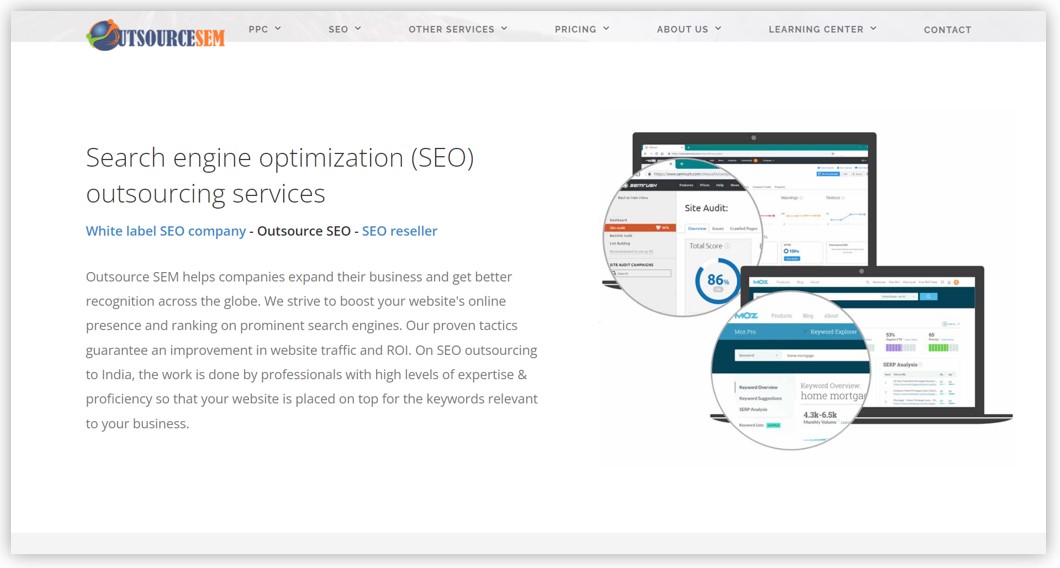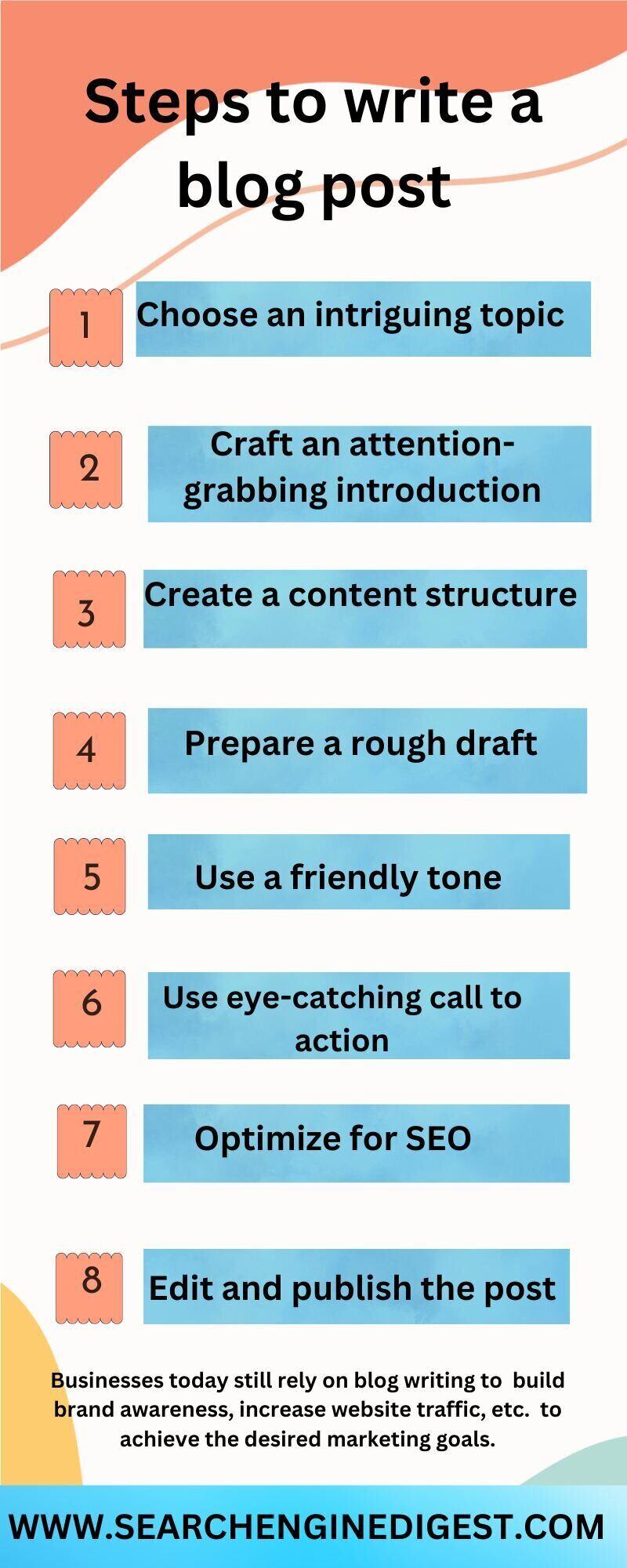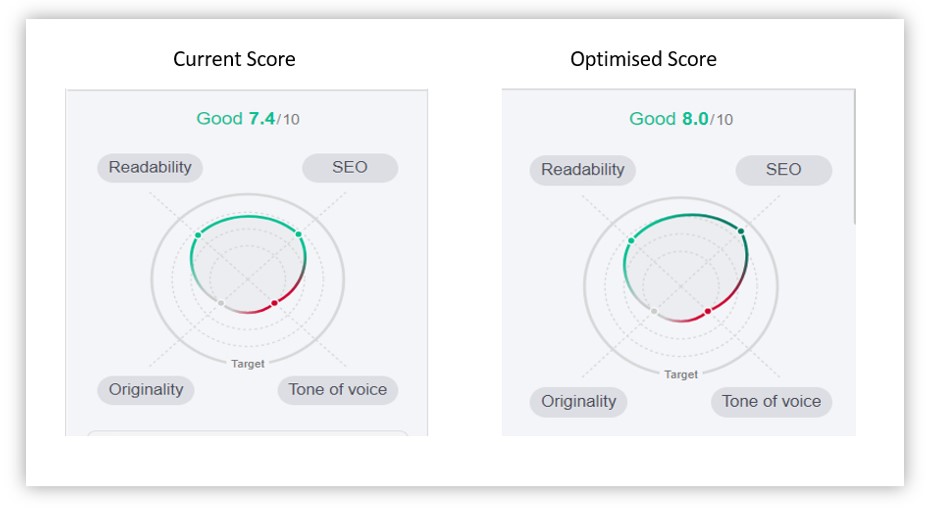Around 60% of people read a blog post every week. Businesses today still rely on blog writing to build brand awareness, generate leads, increase website traffic, etc., apart from using search engine optimization techniques to achieve the desired marketing goals. This emphasizes the importance of creating engaging blog posts. Learning how to write a fascinating blog post is a crucial skill for any writer. Whether you’re just starting or aiming to become a content specialist with blog writing, article writing, content writing, etc., it is essential to know the nuances that grab the readers’ attention. Great content can inform, educate, and connect with readers from all over the world. One of the main challenges of writing blog posts is producing engaging content that increases users’ time spent on the page and engages them to keep reading ahead. But don’t worry! Our comprehensive guide on “How to write a blog post” will help you get started with blog writing and provide crucial tips to produce engaging and unique content that will leave a lasting impression on your readers.
What is a blog post?
Regularly updated web pages that offer insight on a certain subject are called blogs. The word blog stands for “Weblog”. Blog is a melding of the terms “web” and “log.” Blogs were once only a way for people to keep a record of their day-to-day lives online. But now, they have become crucial for updating and exchanging information between people and corporations. With online marketing being different from traditional marketing, blogs today have many useful aspects to focus on, like increasing organic traffic, building brand awareness on social media platforms, reaching new customers, increasing social media followers, etc. A blog post is an online article or a journal that gives information on any particular topic, recommendations, and reviews. A blog post contains text as well as insightful infographics, videos, and other collective charts. As there is a huge demand for industry-oriented people with proper knowledge about the given topic, it is essential to have content specialists who write on topics with complete knowledge. To ensure that the website has quality content, many websites also provide guest blogging opportunities.
Even in the world of digital marketing today, like email marketing, content marketing, etc., blogs play a vital role in conveying important messages to the target audience. The significance of blogs can be understood by the fact that many websites hire guest bloggers to write engaging blogs for their websites. Blogs help build brand recognition and increase website traffic. It helps improve user engagement rate and when quality backlinks are added, it helps redirect users to the desired landing page.

Why are blog posts important?
Blog writing is a fantastic method for refreshing a website with new information. Readers are interested in finding solutions to issues and blogs provide them with answers to their questions that solve their queries to a greater level. Businesses may publish blog links on social media platforms like Facebook, LinkedIn and Twitter to encourage readers to visit their websites. Blog posts help drive traffic towards the company’s websites, increase user engagement, increase visitors’ time on the webpage, etc. By blog writing, websites can boost business growth and increase opportunities to attract new users and convert visitors to customers on the webpage. It also helps in increasing brand awareness and brand recognition. Brand recognition can also increase through guest blogging. Writing and posting a blog article on another person’s or business’s website is known as guest blogging. Most guest bloggers are credited with their author byline for their contribution with a link to their website. Following are the steps for writing an alluring blog post.
Steps to write a blog post

- Choose an intriguing topic
The cornerstone of great blog content is starting a blog from an engaging subject that attracts your reader’s interest. A distinctive and interesting topic is what distinguishes your material amid a sea of blogs and grabs user attention. Topics like finance, business, beauty, fashion, gaming, technology, etc., are the areas where people want to engage more. Determine your target audience and their interests before selecting a topic. Think about the difficulties people encounter, the queries they have and the answers they seek. Find a unique approach to set your blog article apart from others in your field by brainstorming ideas, doing keyword research, consulting personal experiences, and much more. To choose engaging topics, you can consider the below-mentioned pointers:

-
- Keyword research – While choosing a blog topic, it is necessary to do keyword research. By conducting keyword research, you can provide relevant information on new subjects, trends, and phrases pertaining to your sector. It enables you to find fresh content ideas, spot market gaps, and match your initiatives with the target audience’s preferences. Conducting keyword research is also used by pay-per-click advertising and search engine optimization.

-
- Know your target audience – A target audience is a group of individuals that a company focuses on to attract with its goods, services, or information. Similar interests, requirements, demographics, or other traits would make this group more likely to be interested in what your company offers. They also drive traffic to your website. To know your target audience, you can do market research, conduct PPC keyword research, conduct SEO keyword research and perform competitor analysis.
- Unique headline – Making eye-catching headlines that capture the user’s attention will increase conversions, clicks, and marketing effectiveness. Everywhere, including email marketing, pay-per-click, search engine optimization, etc., the concept of a distinctive headline is used. It functions flawlessly everywhere. The main motive of a headline is to short and quickly bring attention to the subject. It also strengthens the brand message and drives more organic traffic towards it.
- Craft an attention-grabbing introduction
A blog post’s eye-grabbing opening paragraph may hold readers’ interest from the very start and engage them to read on. As the adage goes, “First impressions matter,” and this is also true with blog writing. Your opportunity to leave a lasting impression, grab the reader’s attention and persuade readers that your information is worthwhile comes initially. You must ensure that readers are fascinated from the start and don’t put down your post until the end if you want them to read your material from beginning to end. The secret is to create a fantastic blog introduction that sparks readers’ interest and makes them want to read more.
- Create a content structure
It’s crucial to outline the structure of your blog post before you start writing. Your readers can quickly follow your ideas in an orderly and clear manner. Write your text into sections and paragraphs, using distinct headers and subheadings for each section. This type of blog post format will help your readers explore and comprehend the information you provide. The hook in your introduction should entice people to read the rest of your blog content. This structure will help your readers explore and comprehend your information while helping you stay focused on writing engaging and unique content.
Your introduction should captivate people to read the rest of your blog content. Start by posing a challenging question, revealing startling statistics or fascinating tales about your subject. Indicate clearly your blog article’s goal and the benefits readers will receive from it. An interesting opening sets the tone for the rest of your post and encourages readers to continue reading. If readers stick around, both the conversion rate and the effectiveness of your content marketing are enhanced.
- Prepare a rough draft
A preliminary draft should be written when you begin writing blog content. This can be done by simply summarising anything that is relevant to your content and dividing it into several pieces. When you focus on preparing a rough draft, your post won’t be ruined later on if you just let your thoughts flow naturally and express all of your crazy and unexpected ones. If you are beginning with blog writing, you must focus on writing from users’ perspectives. You need to read it first to know what it would look like when the readers look at it. As for your paid ad campaigns, you avoid PPC mistakes; for SEO campaigns, you avoid SEO mistakes, etc. Similarly, preparing a rough draft would help you avoid any mistakes in content writing.
This exercise aims to write for a few minutes without considering sentence structure, grammar, punctuation, zero editing, etc. The only person who will ever read this draft is you. This will make it simpler for you to make sense of those ideas and create an integrated tale by allowing you to get your thoughts and ideas about that subject out of your head.
Now that we have created a draft, it’s time to consider it from the readers’ perspective. If you complete this step correctly, the blog article will compose itself. But our blog will only be effective if we perform this step correctly. At this point in time, try to figure out who your audience is and who your reader is. It’s crucial to keep in mind that your audience may be made up of a number of readers while considering your readers. As for your PPC ad campaigns, search engine optimization, email marketing, etc., you focus on strategic marketing and draft a PPC plan, SEO plan, email marketing plan, etc., to avoid any PPC mistakes, SEO mistakes, etc. It helps achieve the desired goals and enhances the performance of your PPC ads, performance of SEO campaigns, etc. So, preparing a rough draft when you begin writing blogs is essential.
- Use a friendly tone
Create a blog post that is more approachable and relatable, written in a conversational style. Communicate with your audience as if you were casually discussing with them. Be clear of technical terms or too formal language to ensure that the users maintain interest when reading your blogs. Instead, make an effort to be real, likable and sincere. Readers get interested in and remain engaged with the content you provide when it is fascinating. By including your own stories, tales or experiences relevant to your topic, you may establish a connection with your audiences, encourage reader involvement and respond to their comments. For writing great content, one can take help from our content specialists.

- Use eye-catching call to action
Using a CTA in writing blogs to encourage participation can improve your relationship with your readers and create a community around your site. It motivates readers to act, converting inactive readers into active participants in the development of your site. After reading your blog article, a well-designed call-to-action (CTA) directs visitors to the following steps. Learn more, click here, find out, swipe up, etc., are a few examples of call to action.
Your call-to-action (CTA) might persuade readers to leave a comment, sign up for your newsletter, follow you on social media, or read related blog entries on your website. A successful CTA is clear, concise and pertinent to the subject matter of your blog post. Whether you are running Google Ads, Microsoft Ads, etc., or social media ads like Facebook Ads, YouTube Ads, LinkedIn Ads, Instagram Ads, etc., it is essential to focus on having engaging CTAs that create a sense of urgency among the target audience to convert. In the same way, with the help of CTAs for your blog, you can achieve your desired goals.

- Optimize for SEO
Once you have the keyword list prepared that you want to target, you can include it at various stages of your blog post. Start with the title because it matters a lot for search engine results. Ensure that the title appropriately represents the content of your piece by including your main keyword naturally into it. Focusing on writing engaging title tags and meta descriptions increases the website performance on the SERPs. Similarly, you need to write unique content for your blogs that improves the blog’s performance on the SERPs.
Employing SEO best practices raises the possibility that readers looking for related subjects will find your blog post. Additionally, create an SEO-friendly URL with your primary keyword in it while avoiding long-tail keywords. Use them in blog posts, headlines, subheadings, and body text. Use your main keyword in your meta title, meta description, and URL optimization to raise your website’s search engine rating. This makes it simpler for search engines to show your blogs for the keywords or search terms entered. You also need to ensure that your blogs are properly indexed so that the search engine bots can crawl your blogs to show relevant results.
High-quality content is the foundation of effective SEO. Search engines value relevant, useful and thorough material. As long-form content frequently performs better in search rankings, focus on depth and substance. Put your energy into writing detailed, interesting information that covers every aspect of the subject of your blog post.
- Edit and publish the post
Before publishing your blog post, you must carefully verify your writing for grammar and spelling problems, reliability and any other substandard content, given an abundance of typical blogging faults. To check your blog post, run your blog article via a grammar checker like Grammarly tool and the standard spell check to correct any contextual errors. Ensure your ideas are consistent throughout each part since this will convey a clear and focused message to readers. This extensive blog post checklist includes information on more crucial elements of blogging. You must also avoid duplicate content to avoid search engine penalties and gain users’ trust in your blogs.
As part of your pre-publishing editing and fact-checking process, you should invite a friend or coworker to give your blog post a final review before publication. Ask them to check for any contradictions or ambiguities. Additionally, it’s critical to prioritize quality over quantity to keep your audience engaged and build credibility. Once you’re satisfied with your content writing, you can publish your blog content.
Conclusion
At last, we would like to conclude that starting a blog writing is interesting and brainstorming as well. Writing an engaging blog article on various blogging platforms requires both an articulated writing style and command of the blog topic. You may captivate readers and leave a lasting impression by knowing your audience, organizing your material, and presenting it with originality. A strong conclusion briefly summarizes your article’s main arguments, explaining why they are important, and leaves readers with a positive impression.
Consistently posting and polishing your craft will help your readers and present your blog as a useful tool in the broad online blogging community. Remember that writing is a lifelong learning process as you start your blogging adventure. Accept reader criticism, keep up with industry advances and trends, or change your writing style as necessary. As you focus on PPC trends, SEO trends, digital marketing trends, etc., in your online marketing strategy, you need to analyze the trends and write blogs accordingly. It is essential to be genuine in your voice since that will set your blog post apart and make it interesting.
References
-
306, 2024Understanding Google’s preference for crawling high-quality content
Crawling websites is [...]
-
2905, 2024All you should know about third-party cookies by Google
Cookies have revolutionized [...]
-
2405, 2024Helpful content update by Google to enhance website ranking
Google launched a [...]





Leave A Comment